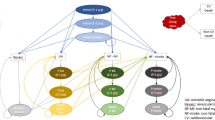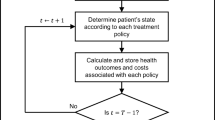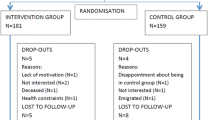Abstract
Objective: To assess variability in patients’ values and preferences regarding cholesterol-lowering therapy.
Design: A descriptive study. Patients currently receiving cholesterol-lowering therapy were interviewed using the time tradeoff and standard reference gamble techniques of utility assessment.
Setting: Internal medicine clinics of a military medical center.
Participants: Thirty-five patients, clinically free of coronary disease, receiving cholesterol-lowering therapy for at least three months.
Results: When the time tradeoff method was applied, 12 (34%) of the patients indicated that less than one month of additional life would be a fair return for adhering to their current therapy for the rest of their lives, while 13 (37%) patients required more than one additional year of life, and four (11%) required at least five years. By the standard reference gamble method, 18 (51%) patients would not have accepted a risk of one in a thousand of imminent death (in 30 days) in hopes of obtaining a normal life expectancy off therapy, while 14 (40%) would have agreed to a 1% or greater risk in order to avoid therapy.
Conclusions: While many patients apparently expected very little in return for adhering to therapy, many others may not be getting “what they bargained for.”
Similar content being viewed by others
References
The Expert Panel. Report of the National Cholesterol Education Program Expert Panel on detection, evaluation, and treatment of high blood cholesterol in adults. Arch Intern Med. 1988;148:36–69.
Lipid Research Clinics Program. The Lipid Research Clinics Coronary Primary Prevention Trial results. JAMA. 1984;251:351–74.
Frick MH, Elo O, Haapa K, et al. Helsinki Heart Study: primary-prevention trial with gemfibrozil in middle-aged men with dyslipidemia. N Engl J Med. 1987;317:1237–45.
Report of the committee of principal investigators. W.H.O. cooperative trial on primary prevention of ischaemic heart disease using clofibrate to lower serum cholesterol: mortality follow-up. Lancet. 1980;2:379–85.
Garber AM, Sox HC, Littenberg BL. Screening asymptomatic adults for cardiac risk factors: the serum cholesterol level. Ann Intern Med. 1989;110:622–39.
Taylor WC, Pass TM, Shepard DS, Komaroff AL. Cholesterol reduction and life expectancy: a model incorporating multiple risk factors. Ann Intern Med. 1987;106:605–14.
Browner WS, Westenhouse J, Tice JA. What if Americans ate less fat? JAMA. 1991;265:3285–91.
Oster G, Epstein AM. Cost-effectiveness of antihyperlipemic therapy in the prevention of coronary heart disease: the case of cholestyramine. JAMA. 1987;258:2381–7.
Reed WW, Herbers JE Jr, Noel GL. Predicted and desired gains in life expectancy due to cholesterol-lowering therapy [abst]. Clin Res. 1989;37:782A.
Johnson JE, Pinholt EM, Jenkins TR, et al. Content of ambulatory internal medicine practice in an academic Army medical center and an Army community hospital. Milit Med. 1988;153:21–5.
Office visits to internists: the National Ambulatory Medical Care Survey (DHEW publication no. 79-1787). Washington, DC: U.S. Government Printing Office, 1978.
Weinstein MC, Fineberg HV, Epstein AS, et al. Clinical Decision Analysis. Philadelphia: W. B. Saunders, 1980;184–223.
Sox HC, Blatt MA, Higgins MC, Marton KI. Medical Decision Making. Boston: Butterworth’s, 1988;167–237.
National Center for Health Statistics. Vital Statistics of the United States, 1985, Volume II, Mortality, Part B. U.S. Department of Health and Human Services Publication No. (PHS) 88-1102. Public Health Service. Washington, DC: U.S. Government Printing Office, 1987.
Block G, Clifford C, Naughton MD, et al. A brief dietary screen for high fat intake. J Nutr Educ. 1989;21:199–207.
McNeil BJ, Weichselbaum R, Pauker SG. Fallacy of the five year survival in lung cancer. N Engl J Med. 1978;299:1397–401.
McNeil BJ, Weichselbaum R, Pauker SG. Speech and survival: tradeoffs between quality and quantity of life in laryngeal cancer. N Engl J Med. 1981;305:982–7.
Holmes MM, Rovner DR, Rothert ML, et al. Women’s and physicians’ utilities for health outcomes in estrogen replacement therapy. J Gen Intern Med. 1987;2:178–82.
Read JL, Quinn RJ, Berwick DM, Fineberg HV, Weinstein MC. Preferences for health outcomes: comparison of assessment methods. Med Decis Making. 1984;4:315–29.
Churchill DN, Morgan J, Torrance GW. Quality of life in end-stage renal disease. Peritoneal Dialysis Bull. 1984;4:20–3.
Churchill DN, Torrance GW, Taylor DW, et al. Measurement of quality of life in end-stage renal disease: the time trade-off approach. Clin Invest Med. 1987;10:14–20.
O’Connor AM, Boyd NF, Till JE. Methodologic problems in assessing preferences for alternative therapies in oncology: the influence of preference elicitation technique, position order and test - retest error on preferences for alternative cancer drug therapies. Proc 10th Natl Nurs Res Conf. 1985:49–58.
Krahn M, Naylor CD, Basinski AS, et al. Comparison of an aggressive (U.S.) and a less aggressive (Canadian) policy for cholesterol screening and treatment. Ann Intern Med. 1991;115:248–55.
Author information
Authors and Affiliations
Additional information
Received from the Fellowship Program in General Internal Medicine, Departments of Medicine, Walter Reed Army Medical Center, Washington, DC, and the Uniformed Services University of the Health Sciences, Bethesda, Maryland. Dr. Reed is currently at the Department of Medicine, Fitzsimons Army Medical Center, Aurora, Colorado. Dr. Noel is currently at the Department of Medicine, Veterans Affairs Medical Center, Portland, Oregon.
Supported in part by the Walter Reed Department of Clinical Investigation. Statistical review by Melissa Damiano, Fitzsimons Army Medical Center.
The opinions or assertions contained herein are the private views of the authors and are not to be construed as official or as reflecting the views of the Department of the Army or the Department of Defense.
Rights and permissions
About this article
Cite this article
Reed, W.W., Herbers, J.E. & Noel, G.L. Cholesterol-lowering therapy. J Gen Intern Med 8, 591–596 (1993). https://doi.org/10.1007/BF02599710
Issue Date:
DOI: https://doi.org/10.1007/BF02599710




